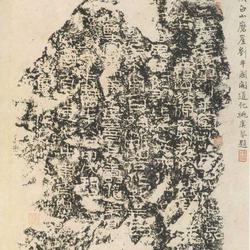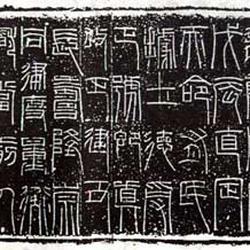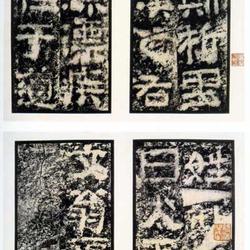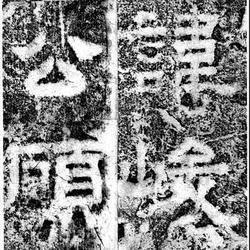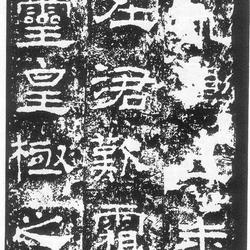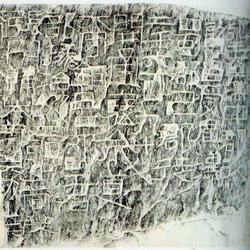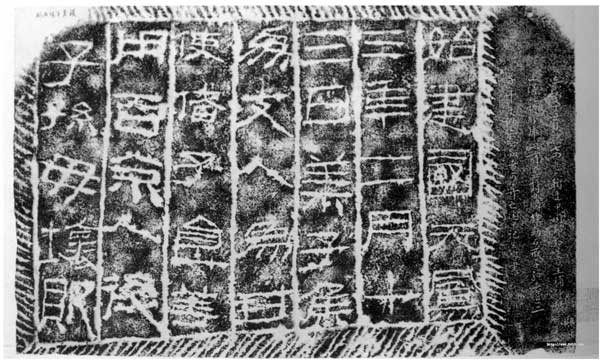
Engraved in February of the third year of Xinmang Tianfeng's reign (15th year). The existing Meng Temple in Zouxian County. It is also known as "Laizihou's engraving stone on the field", "Laizihou's engraving stone", "Laizihou's engraving stone", "Tianfeng engraving stone", "Laizihou's supporting clan's precept stone". There are seven lines, each line has a straight border, and there are five characters in each line, for a total of thirty-five characters. In the 22nd year of Jiaqing in the Qing Dynasty (1817), Xiaolian Yan Fengjia of Knee County and his friend Sun Shengrong came across it by chance in front of Wohu Mountain in the south of Zouxian County in the middle of Wang Fu's journey. The calligraphy on this stone is ancient and clumsy, full of momentum, full of strength, and full of interest. The melted seal script means to write the official script. Fang Shuo of the Qing Dynasty's "Inscriptions and Postscripts on the Painting and Calligraphy of Zhenjing Hall" states: "The seal script is used as the official script, and the structure is simple and vigorous, which means it is ancient and elegant." "There are very few handwritten records of the Western Han Dynasty. Through this stone, we can get a glimpse of the calligraphy style of the Western Han Dynasty.
As for the word "Lai" in this moment, some people use the word "嶪" (prefix of the prefix "Qu Shan"), and some people use the word "Ye" or "Ye", but there is no conclusion yet; there is also controversy over the authenticity of this stone. Feng Yunpeng's "Gold and Stone Suo" says: "Although this stone is not forged by later generations, it was also made in the wild at that time, and it has no profound meaning." In fact, if it is made in the wild among the people, it does not necessarily lack interest. The calligraphy on this stone is ancient and clumsy, with a penetrating and penetrating character, and the pen is round and vigorous with a seal meaning. Jin Ce, the king of Zhucheng, said: "I don't know that the original carving is more authentic than the ancient sentiments because of its simplicity. Today's people can't do anything better than the ancients, but simplicity is beyond the reach." This is quite insightful. Yan Fengjia wrote in his inscription that at this time, "we are members of the same family as Qufu's Stone Carvings in the Second Year of Wufeng" and "Shui Huojun" Moya." Fang Shuo's "Pillow Sutra's Epigraphic Postscript" also said that it "uses seal script as the official script, has a simple and strong structure, and means It is quaint and elegant, and is as beautiful as the Confucian Temple's "Wu Feng Er Nian Engraved Stones"." Qu Zhongrong's "Jinshi Wenbian" commented on his book: "This time the structure is beautiful and ancient, and it is in the two tombs of "Shanggu Fuqing" and "Zhu Qiqing" Above the stone carvings on the altar, there are still Western Han characters, which are precious." This stone is a famous stone carving in the Western Han Dynasty, together with the stone carvings of King Lu Xiao and the altar stone carvings of the two tombs "Zhu Qiqing" and "Shanggu Fuqing". Traces of the transition of Han Li from ancient Li to modern Li. The Wang family in Yixian County, Shandong Province has an engraving.
Explanation: On the 13th day of the second month of the third year of Tianfeng's founding of the country, Lai Zihou was appointed as a branch of the people, so that Cao Xiliang and others could use more than a hundred people, so that the descendants would not be ruined.

